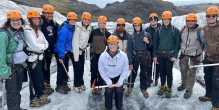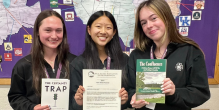Inside a Hybrid Classroom
Reprinted from Traditions, Winter 2020-21
March 24, 2021
Wondering how a classroom works when half the students are joining from home? Step inside a Spanish classroom on a Thursday afternoon to see how it all comes together.
As of March 15, most students are at CDH every day! However, we still have students who have chosen to learn from home who are benefiting from the newfound expertise our faculty has in teaching hybrid classes.
12:10 pm | Students studying from home log in to Google Classroom and Zoom to attend Tommy Murray ’97’s Spanish 101 class during 6th period, while students in the building log in at their desks. A month into second trimester, they’re used to attending school on Zoom two days a week, and can switch seamlessly between virtual and in-person learning. Murray aims to give remote and in-person students equal attention.
Together, they begin class with a prayer in Spanish, and share their intentions. Then, they move on to the day’s activities.
The Google Classroom is laid out with all the activities the students will do throughout the class period, and each activity is coded with an emoji — a purple dot is homework, a book means it’s a Notability assignment, a video game controller means it’s a game. Murray wants to make sure his students always know exactly what is expected of them.
12:15 pm | The class started working on -ar verbs last week, so today’s class starts off with reinforcing those lessons. Students watch a three-minute video on present tense verbs, then a one-minute video introducing a song that will help them remember conjugations.
12:20 pm | Now it’s time to practice! Murray asks the students to practice conjugating -ar verbs with an online game from Purpose Games. His record time is 48.9 seconds to successfully choose the correct conjugation of a verb in 28 different scenarios. On one of his screens, Murray is able to watch and see how each individual students is doing, so he can quickly step in via chat if anyone is struggling.
Murray has learned that it’s hard for students to focus on any single activity for very long on a Zoom, so he always tries to keep class moving quickly.
“It’s hard for anyone to stay engaged in a Zoom meeting for long,” he said. “So I chop things up, I’ll introduce something quickly, in five or ten minutes, and then immediately apply it to a learning activity that can be done online.”
12:30 pm | Murray is a big believer in Multiple Intelligences, and in giving students a variety of ways to practice their skills. The next class activity is on Flippity, a website that allows teachers to create custom activities. This one asks students to organize verb conjugations in the correct groups.
“My colleagues and I worked together to find different apps and tutorials to keep students engaged instead of just filling out a worksheet,” Murray said. “Plus, I can get immediate feedback, chat with them individually, and see where there’s a lack of knowledge so I can focus on that for the next activity.”
The students screenshot their work and post it to Google Classroom, where Murray can review it later.
12:45 pm | Students use their virtual textbook on Carnegie Learning to answer questions about culture and education in Spanish-speaking countries. They compare the experience of attending Cretin-Derham Hall to a typical high school in Latin America. Murray believes that understanding culture is a big part of learning a new language, and aims to integrate cultural learning into his language lessons.
They are split into breakout rooms to do the activity, where each at-home student is paired with an in-class student. Murray is able to virtually visit the breakout rooms, check-in with each pair of students, and then call on them to share their answers with the larger group when everyone finishes the assignment.
1:00 pm | They log in to a Kahoot, which is another virtual learning resource. Students are divided into teams for a friendly competition to reinforce what they have already learned.
“Learning is going to change for the better, because the answers can’t be found on Google,” Murray said. “If they can be found on Google, the question isn’t worth asking. Tools are great — I still use a dictionary in Spanish sometimes — but the tool should support the learning, not replace it. We don’t just want students to regurgitate what we teach them, we want them to show proficiency.”
1:10 pm | A big part of learning a language is learning to listen and speak. Murray previously recorded audio of himself saying sentences in Spanish. Students are asked to listen and then write down what they are hearing in Spanish. Then, Murray asks them to illustrate what the sentence says in order to show their understanding, without ever translating the sentence to English.
“When I collect student work, I want it to be authentic and individual and something that really requires higher-level thinking,” Murray explained. “They’re not just copying something or looking it up on Google, they are really thinking while they’re doing it.”
1:25 pm | Class is done! The at-home students will be in class in person in a few days, but the experience won’t be very different from their virtual day today — Murray tries to build his classes so that every student is equally engaged, regardless of where they’re learning from.
“I don’t care if my kids are taking class at home, or in the classroom, or in their car. If they have internet, they can have the same experience as everyone else. We’re all seeing the same thing on the screen, we can all check in together, and we can all have that relationship.”
Subscribe to our e-Newsletters
You might also like:
Students Gain Hands-On Earth Science Experience on Iceland STEM Trip
This June, a group of CDH students went on a STEM trip to Iceland, traveling between volcanoes, glaciers, waterfalls, and geysers to learn about earth and environmental science in one of the world’s most unique geographical regions.
Beyond the Books - June 2025
The latest news from Athletics, Band, Choir, JROTC and Theater.
CDH Juniors Honored with Prestigious Book Awards
Emma Kennefick '26, Annie Fielder '26, and Cecilia Larson '26 received this year’s Harvard, Yale, and Dartmouth Book Awards for their academic excellence, leadership, and character.




